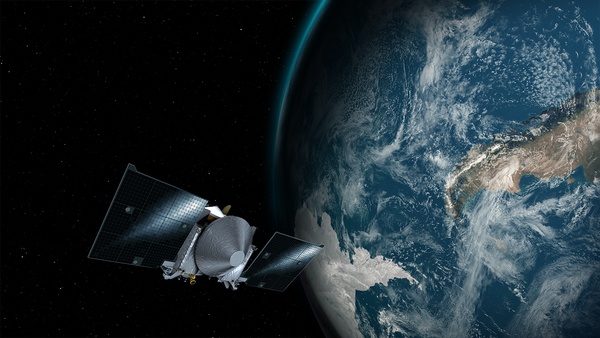NASA's OSIRIS-REx spacecraft will make a close flyby of Earth before shooting out toward the asteroid Bennu, and skywatchers will have the opportunity to wave goodbye to the probe as it passes overhead.
The OSIRIS-REx (Origins, Spectral Interpretation, Resource Identification, Security, Regolith Explorer) mission launched on Sept. 8, 2016, to study and collect a sample from the near-Earth asteroid Bennu. On Sept. 22, the spacecraft will make its closest approach to Earth, offering one last opportunity to see and photograph the probe until it returns to Earth in 2023.
The Sept. 22 flyby will give OSIRIS-Rex a momentum boost—called a gravity assist—toward its target destination. To celebrate the spacecraft's close approach, observers can join the "Wave to OSIRIS-REx" social media campaign. To participate, all you have to do is snap a photo of yourself waving to OSIRIS-REx from anywhere in the world, then post the image using the hashtag #HelloOSIRISREx and tag the mission account in the post on Twitter or Instagram (both under @OSIRISREx). [OSIRIS-REx: An Asteroid Sampling Mission in Pictures]
On supporting science journalism
If you're enjoying this article, consider supporting our award-winning journalism by subscribing. By purchasing a subscription you are helping to ensure the future of impactful stories about the discoveries and ideas shaping our world today.
"The opportunity to capture images of the OSIRIS-REx spacecraft as it approaches Earth provides a unique challenge for observers to hone their skills during this historic flyby," Dante Lauretta, OSIRIS-REx principal investigator at the University of Arizona, Tucson, said in a statement from NASA. "As the spacecraft approaches Earth for its own imaging campaign, ground-based observers will also be looking up and taking photos from the opposite perspective."
OSIRIS-REx will make its closest approach to Earth at 12:52 p.m. EDT (16:52 GMT) on Friday (Sept. 22), when it will be approximately 11,000 miles (17,000 kilometers) above the planet's surface. The spacecraft will use Earth's gravity to slingshot itself toward Bennu, which is located about 140 million miles (225 million km) away. OSIRIS-REx is expected to arrive at the asteroid in 2018 and will spend two years studying the rocky body from orbit before grabbing a few samples to bring back to Earth.
"The team is eager and ready to execute the Earth Gravity Assist," Rich Burns, OSIRIS-REx project manager at NASA's Goddard Space Flight Center in Greenbelt, Maryland, said in the statement. "Not only will it be a significant change in trajectory putting OSIRIS-REx on track for rendezvous with Bennu, it also represents a unique opportunity for the OSIRIS-REx instruments to observe our home planet. It is fantastic that ground based observers are also taking the opportunity to image OSIRIS-REx."
Using ground-based telescopes, observatories and amateur astronomers can track the spacecraft as it sweeps past Earth and submit images of the spacecraft online.
Observers can submit their photos at this mission website, which also includes instructions on how to spot OSIRIS-REx in the sky here (PDF link). Participants can begin taking and sharing photos at any time.
Among the groups participating in the campaign to track the spacecraft are the OSIRIS-REx Target Asteroids! citizen-science program and the Desert Fireball Network based in Perth, Australia. Observers in Australia will have some of the best opportunities to see and photograph the spacecraft as it approaches Earth and then zooms into space.
The Japan Aerospace Exploration Agency—the home institution of several OSIRIS-REx science team members—will also work with the Japan Public Observatory Society and the Planetary Society of Japan to capture images of OSIRIS-REx from various points in Japan.
Editor's note: If you capture a great photo of OSIRIS-REx through a telescope and would like to share it with Space.com and our news partners for a story or gallery, send images and comments in to: spacephotos@space.com.
Visit Space.com Friday for complete coverage of the OSIRIS-REx spacecraft's Earth flyby.
EDITOR'S RECOMMENDATIONS
Copyright 2017 SPACE.com, a Purch company. All rights reserved. This material may not be published, broadcast, rewritten or redistributed.
